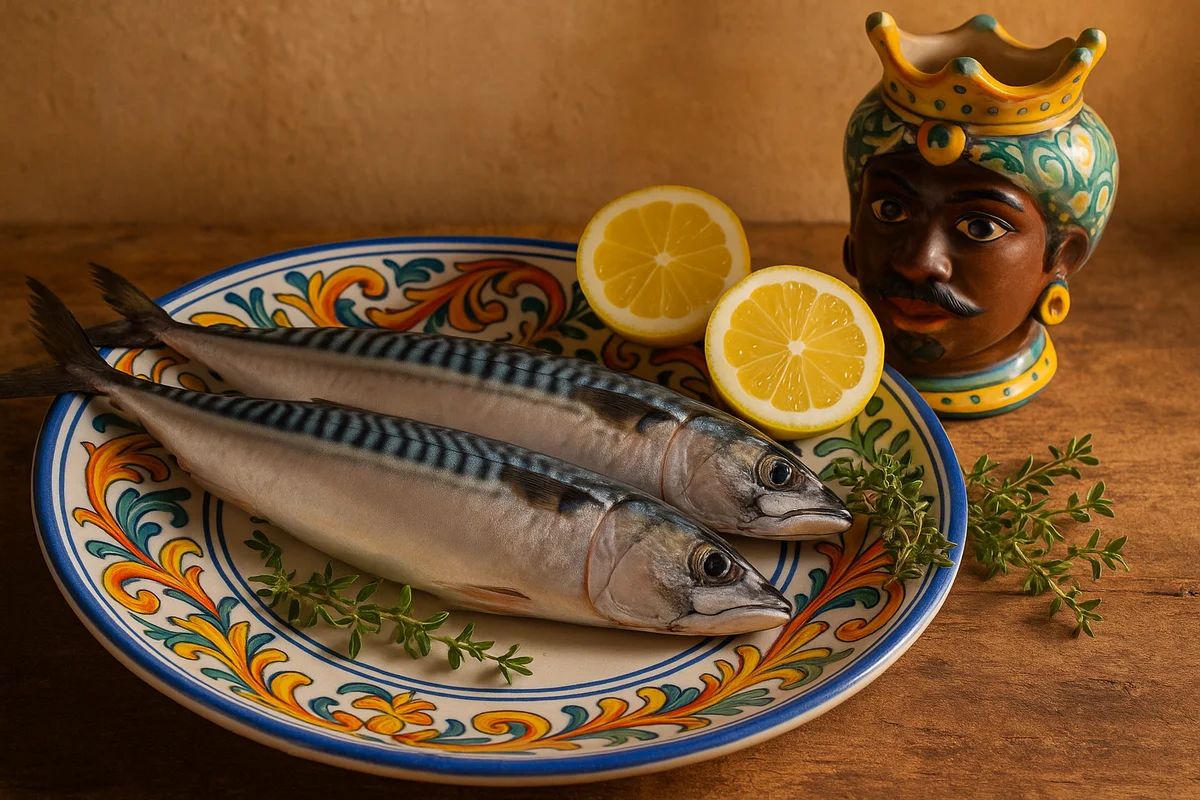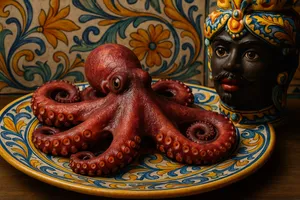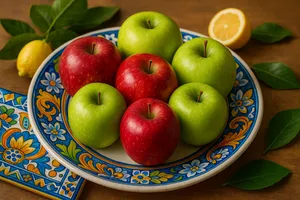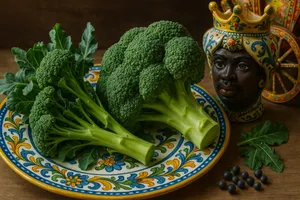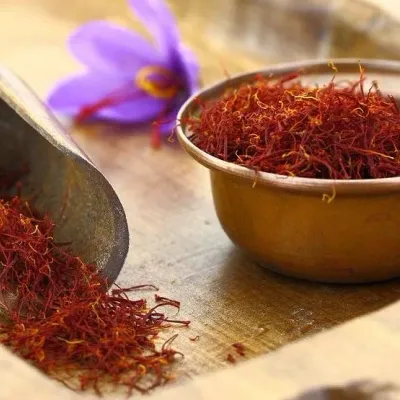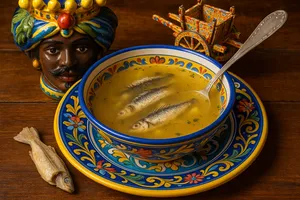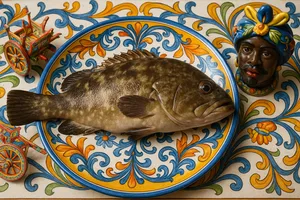Overview
Mackerel is a marine fish belonging to the Scombridae family, characterised by its streamlined body, metallic blue-green back with distinctive wavy dark stripes, and silvery belly. Commonly 25–50 cm long, it swims in large schools across the Mediterranean and Atlantic. In Sicilian cuisine, mackerel is a classic oily fish valued for its rich, fatty, flavourful flesh and exceptional omega-3 content. Traditionally grilled, baked, marinated or preserved in oil, it is considered a “poor” fish only in the sense of being affordable—nutritionally, it is among the richest and most beneficial.
Mackerel fishing in Sicilian waters is seasonal, occurring when migrating schools approach the coast. Freshly caught mackerel has firm flesh, bright colours and a strong yet clean sea aroma. It must be consumed quickly as its fatty meat spoils fast. Distinguishing between Atlantic mackerel (Scomber scombrus) and chub mackerel or “lanzardo” (Scomber colias) is important to fishermen and cooks, though both are used similarly in the kitchen. Mackerel represents the generosity of the sea: nutritious, accessible, deeply flavourful and tied to beach barbecues, seaside gatherings and the essence of honest Sicilian fish cookery.
Characteristics
Mackerel has a long, spindle-shaped, hydrodynamic body built for speed. Its back is metallic blue-green with 10–12 dark wavy stripes, its sides are silvery and its belly bright silver-white. It has two distinct dorsal fins and a deeply forked tail.
Typical size is 25–35 cm, weighing 200–500 g, though large specimens may reach 50 cm and over 1 kg. The flesh is fatty, compact and pink-brown due to higher myoglobin content, with a strong, characteristic flavour and pronounced aroma. The skin is thin with tiny scales.
Fresh mackerel has bright eyes, red gills, a firm body and a strong but clean sea smell. It spoils quickly: without immediate chilling, the flesh begins to develop histamine, and the odour deteriorates. Absolute freshness is essential.
Atlantic mackerel vs chub mackerel (“lanzardo”)
Two similar but distinct species:
Atlantic mackerel (Scomber scombrus): Slightly stockier, with clean continuous stripes on the back and no dark spots on the sides. Fattier, richer flavour. Considered the “true” mackerel and more prized.
Chub mackerel / Lanzardo (Scomber colias): More slender, with less regular stripes and distinctive dark spots along the sides. Slightly leaner flesh but similar taste. More common in the Mediterranean and called “lacertu” in eastern Sicily.
Both species are fished and eaten in Sicily and prepared in the same ways.
Fishing and seasonality
Mackerel lives in large schools in open waters at depths of 10–200 metres, feeding on plankton, small fish and crustaceans. It migrates following temperature shifts and food availability.
It is caught with purse seines, pelagic trawls and lines (including sport fishing). In Sicily, the best season is spring to late summer (April–September), when schools approach the coast.
Mackerel populations are generally well managed, making it a sustainable choice for environmentally conscious consumers.
Cleaning mackerel
Cleaning is straightforward:
1. Rinse under cold water.
2. Remove the head (optional).
3. Make a slit along the belly and remove the innards.
4. Rinse thoroughly to remove blood.
5. To fillet: cut along the backbone on both sides and lift the fillets off. Skin can be left on or removed.
The strong aroma clings to hands and boards—wash with soap and lemon.
Use in Sicilian cuisine
Grilled mackerel
The most iconic preparation. Whole gutted mackerel is grilled over coals or on a griddle, seasoned with olive oil, lemon, oregano and salt. The slight smokiness enhances the flavour. Served hot and filleted at the table.
Baked mackerel
Whole fish or fillets baked with olive oil, lemon, herbs (rosemary, thyme, bay), cherry tomatoes, olives and capers. A delicate yet flavourful method.
Marinated mackerel
Ultra-fresh fillets marinated in vinegar, lemon, olive oil, garlic, parsley and chilli. The acidity lightly “cooks” the flesh. Served cold as an appetiser.
Mackerel in oil
Cooked (boiled or grilled), filleted and preserved in olive oil with bay, peppercorns and garlic. A traditional method yielding a superior result to commercial products.
Pasta with mackerel
Fresh or oil-preserved mackerel flaked into pasta with tomato, garlic, olives, capers and parsley. Hearty, flavourful and economical.
Sicilian sweet-and-sour mackerel
Fried or grilled mackerel marinated in a sweet-and-sour sauce with vinegar, sugar, onions, raisins, pine nuts and spices. Served cold.
Mackerel salad
Cooked mackerel with boiled potatoes, tomatoes, onion, olives and capers, dressed with olive oil and lemon. A fresh, nourishing summer dish.
Mackerel vs tuna and other oily fish
Mackerel: Small, very fatty, intense flavour, affordable.
Tuna: Large, less fatty (depending on cut), milder, expensive.
Sardines/Anchovies: Smaller, less fatty, delicate flavour.
Swordfish: Large, lean white flesh, mild, prized.
Mackerel is the fattest and most robustly flavoured of the common oily fish.
Storage
Fresh mackerel keeps 1–2 days on ice in the coldest part of the fridge. Consume very fresh to avoid histamine formation.
Cooked mackerel keeps 2–3 days refrigerated.
It freezes well (gutted and cleaned), lasting 2–3 months. Defrost slowly in the fridge.
Marinated or oil-preserved mackerel keeps several weeks refrigerated.
Buying tips
Look for absolute freshness: bright eyes, red gills, firm body, strong yet clean sea smell. Avoid dull eyes, dark gills, soft flesh or ammonia/rancid odours.
The skin should be glossy and iridescent, with sharp, vivid stripes. Old fish looks dull and faded.
Prefer locally caught Sicilian mackerel in season (spring–summer), and ensure it has been iced immediately after capture.
Mackerel is inexpensive (around €3–8/kg), abundant and deeply flavourful.
Nutritional properties
One of the most nutritious fish: 100 g provide 200–250 kcal, 18–20 g of high-quality protein and 12–18 g of fat, primarily beneficial omega-3s (EPA and DHA), among the highest in any fish.
Rich in omega-3s (2–3 g per 100 g), with powerful anti-inflammatory and heart-protective effects. Also high in vitamins D, B12, B3, E, and minerals such as selenium, phosphorus, iodine, potassium and iron.
Mackerel supports cardiovascular health, lowers LDL cholesterol, raises HDL, reduces triglycerides and supports brain and nerve function. Small and fast-growing, it accumulates little mercury, making it safe for regular consumption.
Mackerel in Sicilian tradition
Mackerel has long held a place in Sicilian maritime cooking as an abundant, accessible fish. Fisher families ate it fresh during the season and preserved it in oil or marinades for later months.
Grilling mackerel on the beach is a cherished communal ritual, celebrating the sea’s bounty.
Considered humble but nourishing, it sustained labourers with its richness and energy. It remains a “people’s fish”.
Curiosities
Mackerel can swim over 30 km/h thanks to its streamlined body.
Its dark dorsal stripes help camouflage it from predators above by breaking up its silhouette.
Migratory schools travel long distances following warm currents.
Mackerel in oil is known as “caballa” in Spain, “maquereau” in France and “mackerel” in English, appreciated in many coastal cuisines.
Due to its high histidine content, improper storage can lead to histamine formation (“scombroid poisoning”), making prompt refrigeration critical.
In Sicilian dialect, “scùrmu” can playfully describe someone quick or crafty, like the fish.

